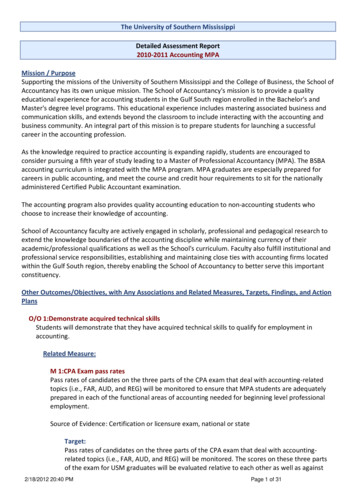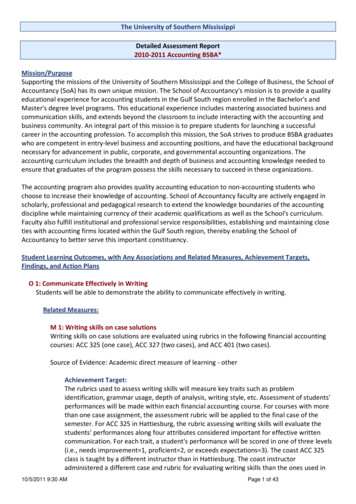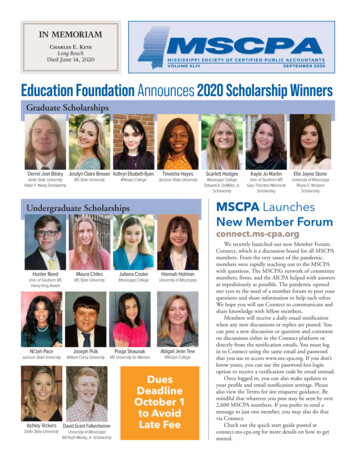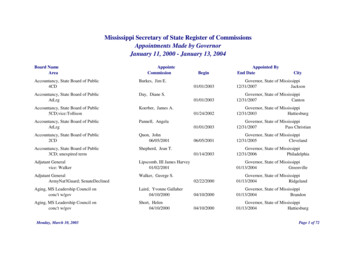
Transcription
The University of Southern MississippiDetailed Assessment Report2010-2011 Accounting MPAMission / PurposeSupporting the missions of the University of Southern Mississippi and the College of Business, the School ofAccountancy has its own unique mission. The School of Accountancy's mission is to provide a qualityeducational experience for accounting students in the Gulf South region enrolled in the Bachelor's andMaster's degree level programs. This educational experience includes mastering associated business andcommunication skills, and extends beyond the classroom to include interacting with the accounting andbusiness community. An integral part of this mission is to prepare students for launching a successfulcareer in the accounting profession.As the knowledge required to practice accounting is expanding rapidly, students are encouraged toconsider pursuing a fifth year of study leading to a Master of Professional Accountancy (MPA). The BSBAaccounting curriculum is integrated with the MPA program. MPA graduates are especially prepared forcareers in public accounting, and meet the course and credit hour requirements to sit for the nationallyadministered Certified Public Accountant examination.The accounting program also provides quality accounting education to non-accounting students whochoose to increase their knowledge of accounting.School of Accountancy faculty are actively engaged in scholarly, professional and pedagogical research toextend the knowledge boundaries of the accounting discipline while maintaining currency of theiracademic/professional qualifications as well as the School's curriculum. Faculty also fulfill institutional andprofessional service responsibilities, establishing and maintaining close ties with accounting firms locatedwithin the Gulf South region, thereby enabling the School of Accountancy to better serve this importantconstituency.Other Outcomes/Objectives, with Any Associations and Related Measures, Targets, Findings, and ActionPlansO/O 1:Demonstrate acquired technical skillsStudents will demonstrate that they have acquired technical skills to qualify for employment inaccounting.Related Measure:M 1:CPA Exam pass ratesPass rates of candidates on the three parts of the CPA exam that deal with accounting-relatedtopics (i.e., FAR, AUD, and REG) will be monitored to ensure that MPA students are adequatelyprepared in each of the functional areas of accounting needed for beginning level professionalemployment.Source of Evidence: Certification or licensure exam, national or stateTarget:Pass rates of candidates on the three parts of the CPA exam that deal with accountingrelated topics (i.e., FAR, AUD, and REG) will be monitored. The scores on these three partsof the exam for USM graduates will be evaluated relative to each other as well as against2/18/2012 20:40 PMPage 1 of 31
Mississippi state averages. The state averages will serve primarily as benchmarks tonormalize the results for a larger group of candidates with socioeconomic and demographicbackgrounds similar to USM graduates.It is expected that, excluding outlier data smallsample observations, the scores of USM graduates will exceed the state average scores forthese three parts of the CPA Exam.Findings (2010-2011) - Target: Partially MetThe CPA exam pass rates for USM graduates and the Mississippi averages for the mostrecent year available (i.e., 2009) from NASBA are as follows:USM MS Avg.FAR - 44.4% 40.6%AUD - 37.5% 42.6%REG - 30.8% 36.9%The above pass rates contain data for all candidates, both first time and repeat candidates.However, only candidates with advanced degrees are included since the purpose here is toevaluate the performance of MPA graduates.As shown above, USM continued its longstanding tradition in exceeding the state's averagepass rate in FAR (i.e., USM's 2009 FAR pass rate of 44.4% surpasses the state's pass rate of40.6%). In AUD, the USM pass rate of 37.5% fell somewhat below the state average for AUDof 42.6%. However, the 2009 USM pass rate in AUD is based upon only eight USMcandidates taking AUD in 2009 (i.e., three of these eight candidates passed AUD). Such asmall base makes the USM AUD pass rate an unreliable measure, as just a small change inthe number of candidates passing AUD would result in a significant change in the pass rate(e.g., if only one more USM candidate had passed AUD, the pass rate would have jumpedfrom 37.5% to 50%). It is unknown why so few USM candidates attempted the AUD portionof the CPA exam in 2009 (i.e., there were approximately double the number of USMcandidates taking the other parts of the exam relative to the number taking the AUDportion). In REG, USM's 2009 pass rate of 30.8% also fell somewhat below the state'saverage pass rate of 36.9%.USM's mean pass rates in 2009 relative to the prior year (2008) are as follows:USM2008FAR - 47.1%AUD - 54.5%REG - 61.9%200944.4%37.5%30.8%USM's 2009 pass rate in FAR (i.e., 44.4%) is approximately the same as the prior year (i.e.,47.1%). USM's 2009 pass rate in AUD (i.e., 37.5% dropped significantly below the prioryear's rate (i.e., 54.5%). As noted previously, however, USM's 2009 AUD pass rate is judgedan unreliable measure because of the small number of USM candidates taking the AUDportion of the CPA exam in 2009. USM's 2009 pass rate in REG (i.e., 30.8%) fell dramaticallybelow USM's pass rate in REG in 2008 (i.e., 61.9%). However, it should be noted that thestate's 2009 overall pass rate in REG (i.e., 36.9%) dropped substantially from the state'sprior year pass rate in REG of 50.5% as well.2/18/2012 20:40 PMPage 2 of 31
Related Action Plans (by Established cycle, then alpha):For full information, see the Action Plan Detail section of this report.AUD and REG CPA Exam ScoresEstablished in Cycle: 2010-2011On the FAR portion of the 2009 CPA exam, USM’s pass rate of 44.4% exceeded theoverall state pass rate of 40.6% in FAR. This con.M 2:ACC 610 Transition Cycles AssessmentIn ACC 610 (Auditing) students will be given a case to determine their understanding oftransactions cycles.Source of Evidence: Written assignment(s), usually scored by a rubricTarget:In ACC 610 (Auditing, students will be given two cases on transactions cycles. The first casewill acclimate them to this rather difficult topic, while the second case will be used forassessment purposes. The two traits will be evaluated by an assessment rubric measuring(1) the ability to identify the need for a cutoff test to determine whether transactions arerecorded in the proper period and (2) the ability to identify transactions that are notrecorded in the proper period. For each of these two traits, students' performances will beassessed as follows:1 did not meet expectations2 met expectations3 exceeded expectationsThe achievement target will have been met if the mean student assessments for each of thetwo traits on the last case equal or exceed 2.2 (out of a possible 3).Findings (2010-2011) - Target: MetOn the first trait (ability to identify the need for a cutoff test to determine whethertransactions are recorded in the proper period), the mean rating for all students was 2.48,with no student performing at the "did not meet expectations" level. On the second trait(ability to identify transactions that are not recorded in the proper period), the meanrating was 2.38, with no student performing at the "did not meet expectations" level.Further discussion:In a prior assessment cycle, while conducting exit interviews of graduating MPA studentssome of the students who had performed internships with CPA firms noted that they feltweak in the area of transactions cycles. To remedy this problem, transactions cyclescases/problems were added to both the undergraduate and graduate auditing classes acouple of years ago. As shown in the results column, all students in ACC 610 in the currentyear performed at least at the "met expectations" level on both traits measuringknowledge and understanding of transactions cycles. In addition, no students mentionedin either their written or oral exit surveys this year that they felt weak in this importantarea (transactions cycles). The same was true in last year's exit interviews as well. Thisdemonstrates a clear "closing of the loop" in our assessment process as a problem wasidentified through our assessment procedures in a prior year, changes were made to thecurriculum to address the problem, and subsequent assessment testing through multiple2/18/2012 20:40 PMPage 3 of 31
cycles shows the problem has been resolved. The AOL team recommends that the ACC610 instructor continue assessing the students' knowledge of transactions cycles in thefuture to ensure this trend remains positive.M 3:Exit InterviewAll graduating MPA students complete an exit interview with the Director of the School ofAccountancy. During this interview students are asked specific questions related to the MPAprogram. Of note, students are asked to decribe the changes in their skill and knowledge levelsexperienced in the MPA program. Additionally students are encouraged to provide anyinformation they believe relevant in improving the educational process. The interview isconducted approximately 3 weeks prior to graduation.Source of Evidence: Exit interviews with grads/program completersTarget:This indirect assessment measure will not only measure student assessments of theirlearning experience throughout the entire MPA program, but also will solicit specific ideason how the MPA program may be improved. The achievement target will have been met ifover 90 percent of the students interviewed assess the MPA program as a "positive"learning experience, and provide the Director at least one constructive idea on improvingthe program.Findings (2010-2011) - Target: MetFor the oral exit survey administered by the SoA Director, on the first question (i.e., Doyou feel your degree has prepared you for your plans academically and otherwise?),Sixteen of the seventeen students answered "yes" and felt strongly about this. Theybelieved the MPA program had increased their knowledge of accounting beyond thatacquired in their BSBA degrees. One student answered "yes and no," with the "no"answer specifically relating to the auditing (i.e., ACC 610) and fraud (ACC 660) courseswhere the student stated that the courses were weak. On the second question (i.e., Arethere areas in which you still feel weak or would have liked more emphasis?), 8 of the 17students answered that they felt weak in auditing (i.e., ACC 610). Several of thesestudents noted that there needs to be more application instruction in the auditing course.They stated that, currently, the course draws heavily on conceptual standards and thatapplication is needed to supplement this.In the prior year's oral exit survey, several students responded to this question by notingthat their understanding of corporate tax was weak and that this was related to theinordinate amount of time they had to spend on corporate finance (i.e., MBA 640)assignments, which drew time away from their studying and comprehension of corporatetax (i.e., ACC 630). As a result of last year's AOL report and its suggestions, the SoADirector spoke with the Finance Department Chair about this problem, and he counseledthe MBA 640 instructor, who as previously noted made changes to the MBA 640 course.In the current year's oral exit interviews, the students said their time devoted to courseassignments were equally balanced among all courses taught in the fall semester (i.e.,when both ACC 630 and MBA 640 as well as two other MPA classes are taught). Themodifications made to the MBA 640 class this year by its instructor appear to haveresolved the apparent weakness in corporate tax noted in last year's oral exit survey as noMPA students this year responded that they felt weak in corporate tax.Based on the judgement of the Director, the students were uniformly positive in2/18/2012 20:40 PMPage 4 of 31
describing their learning experience in the MPA program, and were also forthcoming withconstructive ways in which the program can be improved. Therefore, the achievementtarget was met.Further discussion:Although for assessment purposes less weight is given to indirect measures such as exitsurveys of students than is attached to direct measures, the students' strong beliefs thattheir accounting knowledge and skills improved significantly as a result of the MPAprogram cannot be ignored. This is especially true since the students were adamant aboutthis in both survey instruments (i.e., the written one which provided for anonymousresponses and the oral exit survey with the Director). However, in the written exit surveysin two prior years (i.e., 2007-2008 and 2008-2009), a common suggestion for improvingthe program was to provide additional electives as the students felt the existing MBAelectives were too restrictive. In the 2009-2010 academic year, the content of ACC 660was permanently changed to include two major topics (i.e., fraud and valuation). Inaddition, an accounting elective (i.e., international accounting) was offered in thesummer 2010. In the summer 2011, the international accounting course was againoffered as an elective and all MPA students not involved in the British Studies programtook this elective. In addition, another MPA elective (financial statement analysis) wasoffered in the spring 2011 and was well received by the students. Adding these newtopics/courses to the program resulted partly from the students' recommendations inprior years for additional electives and, more importantly, from the graduate faculty'srecognition that these topics needed to be added to make the program more current andcomplete. Adding these topics/courses to the MPA curriculum reflects a positive "closingof the loop" in that based on the exit surveys in prior years and a review of current trendsin practice the faculty updated the program with additional coverage of relevant topics. Ingeneral, in the current year (i.e., 2010-2011) students did not identify additional electivesas a suggestion for improving the program (i.e., the weakness identified by students inprior years' surveys was not present in the current year after updating the curriculum).In the prior year (2009-2010) in both their written and oral exit surveys, a common pointmade by many students was the inordinate amount of time required to complete theoutside assignments in corporate finance (MBA 640). The complaint here was "not aboutthe instructor," nor about having to take a course that required a lot of work. The issuewas that an MBA elective course required so much out of class time that it negativelyimpacted the students' ability to complete their assignments and study for exams in theiraccounting courses and, in particular, corporate tax. The students believed the workrequired for MBA 640 outweighed the benefits of the course to them as accountants. Thestudents felt their understanding of corporate tax, which is a difficult and time consumingcourse, would have improved if they could have devoted more effort to it (i.e., effort theyfelt was diverted to MBA 640 instead).Based on the students' comments in the exit surveys for 2009-2010, the SoA Director andthe graduate accounting faculty believed the structure of corporate finance wasinappropriate for MPA students. The SoA Director met with the Department Chair ofFinance to determine a solution to this problem. The new coordinator of the MPAprogram also became involved in this process. The Finance Department Chair wasreceptive to the SoA Director's concerns and, in consultation with the MBA 640instructor, decided to offer an additional section of MBA 640 in the fall 2010 that wouldbe taught only to MPA students (i.e., previously, MPAs and MBAs took the same section).The new section of MBA 640 for MPA students was taught in a time period so that it did2/18/2012 20:40 PMPage 5 of 31
not overburden the MPA students (i.e., it was not taught on the same day as any MPAclass). In addition, the MBA 640 instructor cut back on some of the time consumingassignments that had been made in prior years, while still maintaining a rigorous course.These changes freed up time for the MPA students to devote to their MPA classes and, inparticular, corporate tax. The result was an improved performance of the students incorporate tax in the fall 2010 relative to their performance in the fall 2009. In addition,unlike the 2009-2010 academic year when students stated in their exit surveys that theirunderstanding of corporate tax was weak due to their inability to devote the time neededto this class, no students in their 2010-2011 exit surveys indicated they felt weak incorporate tax. Plus, in their exit surveys for 2010-2011, the students did not indicate MBA640 took an inordinate amount of their time but instead viewed its time requirements onpar with their other classes. This represents a clear "closing of the loop" in ourassessment process as a problem was identified through our assessment procedures in2009-2010, curriculum changes were proposed in the 2009-2010 assessment report andacted upon in the 2010-2011 academic year, and assessment results for 2010-2011suggest the problem has been resolved.Although the 2010-2011 written and oral exit surveys indicate the above problems withMBA 640 and ACC 630 (i.e., corporate tax) have been resolved, they point out anotherproblem in need of attention. In particular, a number of students felt weak in the area ofauditing and primarily with respect to their ability to apply the concepts learned in thecourse. As many of our MPA program's graduates will begin work as auditors immediatelyafter graduation, the assessment team understands the students' concerns and believesthe auditing course (ACC 610) should incorporate more application-based instruction. Theconcepts taught in this course should continue to be a focal point but should becomplemented with more hands-on learning experiences. At a minimum, the assessmentteam recommends that a comprehensive audit practice set be incorporated into ACC 610as an extended out-of-class project during the semester. Such a practice set has beenused successfully in this course in the past, and it seemed to give the students amplepractical experience in applying the concepts they were learning in class. The assessmentteam will review the students' responses to their exit surveys next year (i.e., 2011-2012)to ascertain whether the implementation of the audit practice set resolves this issue. This"tweaking" of this courses' pedagogy is not sufficient to trigger an Action Plan.Related Action Plans (by Established cycle, then alpha):For full information, see the Action Plan Detail section of this report.Monitor MPA student time constraintsEstablished in Cycle: 2009-2010Based on the students’ comments in the exit surveys for 2009-2010, the SOA Directorand the graduate accounting faculty believe .M 4:Comprehensive examPrior to graduation, all MPA students are required to take a comprehensive exam, containingquestions from all accounting courses taught in the MPA program. The questions for each topicalarea are prepared by those faculty members teaching the particular topics. The exam is designedto be challenging and to measure a base level of comprehensive technical accounting skills, aswell as highlight technical skills in each of the subject areas tested (e.g., auditing,cost/managerial, tax, etc.).Source of Evidence: Comprehensive/end-of-program subject matter exam2/18/2012 20:40 PMPage 6 of 31
Target:To meet the achievement target, a student will attain a score of 70 (out of 100) or greateron the comprehensive exam.Findings (2010-2011) - Target: MetOn the comprehensive exam administered to graduating MPA students in 2010-2011, themean and median scores were 84.5 and 85.0, respectively (i.e., out of 100). The examcovers all accounting courses required in the MPA program and is designed to berigorous; thus, an average score of almost 85 is acceptable. In addition to the strongoverall score on the comprehensive exam for the group, all students individually scored atacceptable levels with the scores ranging from 75 to 93. Finally, the MPA comprehensiveexam tests the six major areas (i.e., courses) of accounting taught in the MPA program(i.e., cost, entity taxation, auditing, tax research, financial theory, and fraud/valuation),and the students performed well on each of these individual sections with averagecorrect response rates ranging from 75% in entity taxation to 91% in auditing.Further discussion:On their comprehensive written exit exam in 2010-2011, the MPA students performedwell (i.e., mean and median scores of 84.5 and 85, respectively). Even though thestudents performed well overall on their comprehensive exit exam in the prior year (i.e.,mean and median scores of 79.64 and 83.1, respectively), it was noted in that year thatthe students consistently scored poorly on two questions. One question dealt with theparticular circumstances that require a company to report dual EPS. The question wasreviewed by the appropriate faculty and found to be a valid question testing an importanttopic. The second question missed by a large percentage of students concerned thejustification for using fair value measurements in the balance sheet and was aimed atdetermining students' base level understanding of why fair value measurements areimportant. In last year's assessment report, the assessment team recommended that theACC 605 instructor emphasize both of the above topics more in class. On the 2010-2011MPA comprehensive exam, the students performed much better on the questionaddressing the justification for fair value reporting relative to their performance in theprior year. This demonstrates a "closing of the loop" as a weakness was identified throughthe prior year's assessment procedures, the curriculum was appropriately adjusted basedon recommendations in last year's assessment report, and the current year's assessmentresults indicate the problem has been corrected. However, on the other question, whichinvolved determining when dual presentation of EPS is required, the students continuedto perform poorly in 2010-2011. The particular question was reviewed by the appropriatefaculty, and, although it was considered a difficult question, it was deemed anappropriate question testing knowledge of an important topic. The assessment teamrecommends that the ACC 605 instructor determine a new method of ensuring that thistopic is adequately understood by the students. The particular method of delivery is leftto the instructor's discretion, but the students' performance on this topic/question will beevaluated again next year through the MPA comprehensive exam to determine if theissue has been resolved. This "tweaking" of the curriculum is not sufficient to trigger anAction Plan.M 5:Exit surveysAll graduating MPA students will complete a written exit survey. On this survey, the students areasked how they believe their technical skills, critical thinking skills,ability to work as a team,oralcommunication skills,and knowledge of the business environment have changed as a result of2/18/2012 20:40 PMPage 7 of 31
the MPA program.Source of Evidence: Exit interviews with grads/program completersTarget:Student responses are recorded on a 5 point scale, i.e., 3 neutral, 5 technical skill hadincreased significantly. The achievement target will have been met if the mean studentresponse is equal to or exceeds 4.0.Findings (2010-2011) - Target: MetConcerning the accounting skills or knowledge they had gained in the MPA program, onthe written exit survey graduating MPA students were asked to respond to the followingstatement: "Knowledge of technical skills in accounting that will be useful to you in yourcareer as an accountant." Students responded to this statement by selecting one of fiveresponses on a 5-point Likert scale (i.e., running from 1 to 5). A 5 indicated their"knowledge or ability has improved significantly" while a 1 indicated their "knowledge orability has weakened significantly." The neutral response (i.e., 3) was "knowledge orability has not changed." The mean response for the 17 students taking this survey was4.76, which suggests they felt their level of accounting knowledge had increasedsignificantly as a result of the MPA program.In the open-ended comments section of the written exit survey, several students notedthat the out-of-class assignments really helped them learn the material covered andgreatly expanded their knowledge compared to merely studying for exams. In addition, inthe prior year's exit survey, numerous students commented that the MBA 640 class (i.e.,corporate finance) was too time consuming for the value it added to their knowledgebase. Furthermore, the inordinate amount of time spent on the outside assignments inMBA 640 detracted from the students' time available for their accounting courses, inparticular corporate tax where many students performed poorly that year. Based onrecommendations in last year's AOL report, the SoA Director met with the FinanceDepartment Chair and discussed this problem with him. Suggestions were made to theFinance Department Chair that changes be made in the MBA 640 class. These changeswere incorporated in the delivery of the MBA 640 class and in the outside assignmentsmade in the class this year. The result was that no MPA students noted problems withthis course in their written exit surveys for the current year and, more importantly, thestudents' performances improved in corporate tax (i.e., ACC 630) in the fall 2010 relativeto their performances in this class in the fall 2009 as a result of their having more time todevote to ACC 630 in the fall 2010 (i.e., time that had been devoted to MBA 640 in theprior year).In the current year's open-ended comments in the exit survey, though, a couple ofsuggestions were made to improve the program and its delivery. First, three studentsnoted that teaching classes in three-hour time slots is too long and it makes it difficult forthe students to synthesize the information. They prefer classes that meet twice a week intime periods of an hour and fifteen minutes. Two students also commented that thefraud (i.e., ACC 660) and auditing (i.e., ACC 610) courses needed more applicationinstruction to go along with the "book" learning or concepts taught.O/O 2:Identify relevant information and think criticallyStudents will be able to identify relevant information and think critically in making decisions.2/18/2012 20:40 PMPage 8 of 31
Related Measure:M 5:Exit surveysAll graduating MPA students will complete a written exit survey. On this survey, the students areasked how they believe their technical skills, critical thinking skills,ability to work as a team,oralcommunication skills,and knowledge of the business environment have changed as a result ofthe MPA program.Source of Evidence: Exit interviews with grads/program completersTarget:A Likert scale of 1 to 5 (with 1 being "critical thinking ability weakened significantly," 3 being"critical thinking ability did not change," and 5 being "critical thinking ability improvedsignificantly") will be used in the exit survey to ascertain whether the students believe theircritical thinking skills had been enhanced as a result of the MPA program.The achievementtarget will have been met if the mean student response is equal to or exceeds 4.0.Findings (2010-2011) - Target: MetA Likert scale of 1 to 5 (with 1 being "critical thinking ability weakened significantly," 3being "critical thinking ability did not change," and 5 being "critical thinking abilityimproved significantly") was used in the written exit survey to ascertain whether thestudents believed their critical thinking skills had been enhanced as a result of the MPAprogram. For the 17 MPA graduates, the mean response on this question was 4.76, withapproximately 75% of the students indicating that their critical thinking skills hadimproved significantly as a result of the MPA program. In the open ended comments inthe exit survey, multiple students noted that the out-of-class assignments in the programincreased their "thinking" skills.M 6:ACC 660 project assignmentMPA students enrolled in ACC 660 are assigned a project at the end of the semester that isdesigned to assess their critical thinking skills.Source of Evidence: Academic direct measure of learning - otherTarget:Using a rubric to assess critical thinking, students will be evaluated on four attributes. Thefour attributes are identification of the problem, analysis of issues involved, development ofa conclusion for the problem, and justification of the conclusion. For each attribute, astudent's performance will be assessed as either advanced, proficient, minimally acceptable,or unacceptable.The achievement target will have been met if 80 percent or more assessedstudents are classified as "advanced" or "proficient."Findings (2010-2011) - Target: MetOn the rubric applied to the critical thinking assignment in ACC 660 in the spring 2011, thevast majority of students (i.e., 95%) scored at the "proficient" or "advanced" levels on allfour measured attributes. No students scored at an "unacceptable" level. The detailedresults of this assessment for the 22 students enrolled in ACC 660 are as follows :TraitIdent.Analysis2/18/2012 20:40 ceptable0%0%Page 9 of 31
Conclusion 40%Just.27%55%68%5%5%0%0%Further discussion:In ACC 660, which was taught during the spring 2011, the instructor gave a criticalthinking assignment at the end of the semester, and all students performed at the"minimally acceptable" level or above on all four critical thinking traits measured. Theoverwhelming majority of the students (i.e., 21 of 22 students) scored higher than"minimally acceptable." This result is not surprising given the results on the criticalthinking assignments in ACC 605, which was also t
The University of Southern Mississippi . Detailed Assessment Report 2010-2011 Accounting MPA . Mission / Purpose. Supporting the missions of the University of Southern Mississippi and the College of Business, the School of Accountancy has its own unique mission. The School of Accountancy's mission is to provide a quality










